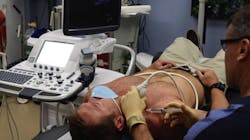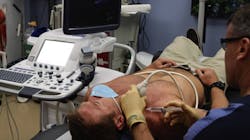Say the acronym "PTSD" (post-traumatic stress disorder) and people naturally think about combat veterans or first responders. But there are other professions with above-average sufferers, and truck driving is one of them.
Although there are no statistics, healthcare givers know anecdotally that because of the trauma caused by a crash, witnessing a fatal or particularly gruesome vehicle accident, or experiencing "'suicide by truck," drivers often suffer from PTSD.
Currently, most sufferers are treated with medicines and talk therapy with varying degrees of success. However, a relatively new technique known as SGB or Stellate Ganglion Block is showing promise in treating, even curing PTSD. In fact, based on positive results from preliminary testing, the US Army is funding a larger study of SGB.
Fleet Owner spoke with Kristine Rae Olmsted, a research epidemiologist at RTI International, a nonprofit research institute, whose landmark work in this area has been featured on 60 Minutes, NPR and in The Wall Street Journal. The study was published in the peer-reviewed journal JAMA Psychiatry.
Following is an edited interview with Rae Olmsted.
Fleet Owner: How do you describe PTSD to someone who does not know anything about it?
Kristine Rae Olmsted: PTSD is a diagnosis that consists of four different categories of symptoms. It needs to be diagnosed by a credentialed provider. The four categories of symptoms are intrusions, things like flashbacks. Another is avoidance, avoiding situations that make you think about the trauma. For truck drivers, that would be pretty difficult because that's their livelihood. The next criterion for diagnosis has to do with alterations of mood and cognition. People have a tendency to start thinking that they're bad and that no one else can be trusted, that they're going to have a short lifespan, things like that. Last, arousal and reactivity changes. This is really jumpy, irritable behavior, such as an easily-startled person. These are people who always face the door at a restaurant, for instance. These are the primary four criteria that I tell people about.
FO: So, PTSD can only be diagnosed by symptoms?
Rae Olmsted: There is no blood test, but we have really good diagnostic questionnaires or interviews that are administered by a clinician.
FO: Does stress play a role in PTSD?
Rae Olmsted: Stress is not necessarily a requirement of PTSD. I think it's more being in a job where one has a higher likelihood of being exposed to traumatic events. Vehicular crashes are a significant contributor to PTSD that most people don't even think of.
FO: What exactly is SGB?
Rae Olmsted: The stellate ganglion is a bundle of nerves in the neck above your collarbone. Think of it as a train station that governs the sympathetic nervous system or what we think of as the 'fight or flight' response. This train station has tracks, if you will, that go off to a bunch of different parts of the body. It's not just related to the brain. It's linked throughout the whole body.
During a stellate ganglion block, a credentialed provider injects a small amount of a local anesthetic. It's very similar to Novocaine in a dentist's office. The stellate ganglion is anesthetized and numbed for four to six hours until the medication wears off. Once it wears off, people believe that the reason the PTSD symptoms don't come back is because somehow the procedure resets that fight or flight nervous system in the stellate ganglion. But beyond that, nobody really knows exactly how it works. We just know that it does work as a result of the research that we just concluded. I did not discover SGB. It's been around for nearly a century to treat certain pain-related syndromes, the most common of which is called 'chronic regional pain syndrome.'
FO: Describe your tests.
Rae Olmsted: My work in this particular study was exclusively with active-duty service members, not with veterans and not with civilians. Now, I want to be very clear that we did not require people to have PTSD as a result of military trauma. It could have been sexual assault. It could have been a vehicular accident. It didn't have to be combat trauma. We used active-duty service members, because there's a higher prevalence of PTSD in that population than in the general public.
The most important things we learned are that the people who received SGB treatment got significantly better. Their PTSD scores went significantly down, enough to be clinically significant. Not only did the people in the SGB group get better, but they got much better than the people in the sham or placebo group. These are our two primary findings that are really the take-home messages of the research.
FO: Why do some people suffer PTSD but others, with similar traumas, do not?
Rae Olmsted: A lot of people would surmise that it has to do with genetics and epigenetics, and I think that's probably the most likely scenario, but I think you also have to take into consideration a person's ability to cope with adverse events, their social networks, the degree to which they have people around them whom they feel like they can talk to. I think it's biological, and I think it's also the environment in which people live. If you ask a geneticist or an epigenetics person, they're going to say, 'It's the genetics of the person.' If you ask a psychologist, they might well say, 'It has to do with the environment they live in.' I think it's a combination of both, but it's never been definitively proven.
FO: Your work focused on military members. Could SGB help truck drivers with PTSD?
Rae Olmsted: I think it could be helpful for anybody with PTSD. We had people who ran the gamut in terms of the traumatic exposures that caused their PTSD. We had a mortuary worker who had PTSD. We had people who were victims of sexual assault. We had people who had witnessed or been in a vehicular accident. Arguably, anybody with PTSD has the possibility of being helped by SGB. I think the takeaway message is that our research shows that SDB works, but we don't know why it works. We just know that it does. There's additional research needed to determine why it works and for whom.
About the Author

Larry Kahaner
Larry Kahaner is an author, journalist, and former FleetOwner contributor.

